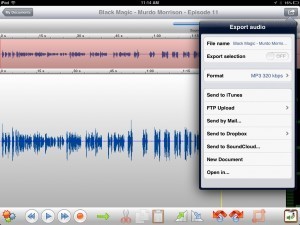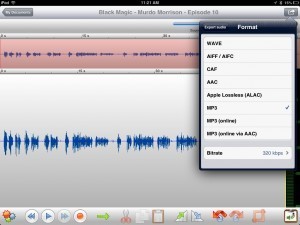Murdo Morrison's Blog
March 29, 2015
Capturing Wildlife Images and Video
Recently I have been experimenting with various methods to capture images and video of birds and other wildlife in my garden. I would like to share with you what I have learned and show you some ways to accomplish this.
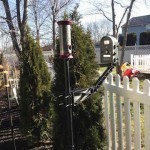
My Wingscapes camera set up
Dedicated Cameras
There are a few manufacturers who make cameras dedicated solely to the task of capturing images and video of birds and other wildlife. One of the better known is Wingscapes. Wingscapes makes a number of cameras ranging in price between $100 and $200 depending on model. I found an older unused model on eBay and set up the camera on one of the feeder poles using the adjustable camera arm that is available as an accessory. The image to the right shows my set up.
The built in motion sensor allows capture of still and video images. There is a built in flash for night photography and the camera also has a time-lapse feature. I have included some examples of the still images captured by the camera. Overall, this camera works quite well. However, it is quite large, requires four D-cell batteries (the current Birdcam Pro uses six C-cells), and the video quality on my model was SD only. The video specs for the current Birdcam Pro are listed as AVI – 640 x 480 at 30FPS. The current specs for still images are listed as 8.0 MP, JPEG, Low 640 x 480, WideHD 1920 x 1080, High 2592 x 1944, Max 3264 x 2448.
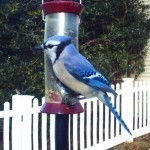
An image of a Blue Jay captured by my Wingscapes camera
I tend to use the camera primarily for still images. A number of accessories are available for the cameras, including straps for mounting on a tree or post, the camera arm mentioned above, and power supplies for extended operation. The camera is also threaded for mounting on a camera

A Junco approaches the feeder as captured by my Wingscapes camera
tripod. The most recent model, the Birdcam Pro, is described as having the capability to use an optional WiFi SD card to send video and images to your computer. For those wanting to capture images of wildlife the Wingscapes Birdcam is an acceptable solution.
Action Cameras
My son has been able to capture very good bird images using his GoPro Hero camera. These cameras tend to be expensive so I looked at a variety of the other cheaper action cameras that have been produced recently by various companies. The marketplace for these can be quite confusing in terms of sorting out the various models and their capabilities. I started off with a camera made by EKOO. One of the main features I wanted in selecting a camera was the ability to control the camera using WiFi. I wanted a range of anywhere from 20 to 25 feet.
My assumption at first was that these would work in conjunction with my WiFi network. In fact, the cameras produce the

Close up of the camera in it’s weatherproof case
WiFi signal. Control of the camera is made possible by apps for IOS and Android devices. The EKOO camera WiFi worked OK at shorter ranges but tended to drop out at the longer distances I wanted.range of anywhere from 20 to 25 feet. My assumption at first was that these would work in conjunction with my WiFi network. In fact, the cameras produce the WiFi signal. Control of the camera is made possible by apps for IOS and Android devices. The EKOO camera WiFi worked OK at shorter ranges but tended to drop out at the longer distances I wanted.
Further research led me to the SJCAM 4000 action camera. My tests using this camera and its associated app have thus far been successful. Using the app provided by the manufacturer on my iPhone I have been able to control the camera over a distance of about 25 feet with line of sight through a window. The WiFi connection appears stable (thus far I have experience no drop outs)
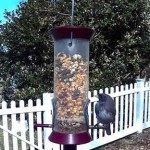
Image of a dark-eyed Junco captured by the SJCAM4000
and I have been able to remotely control the camera to capture still images and video. A nice feature is that I am also able to change the camera settings through the WiFi link. The camera can also be set in various automatic modes including using motion sensing and taking images at specified intervals. While the Wingscapes camera produces its best results in bright direct light, the SJCAM 4000 allows adjustments for cloudy skies and it is also possible to increase or decrease exposure settings.
The SJCAM 4000 ranges in price from approximately $80 to $100 depending on source and comes with a range of accessories including a water resistant case and many different attachments for connecting the camera to bicycles, bike helmets, etc. The water-resistant case and another attachment for holding the camera are threaded to accommodate a standard camera tripod connector. This allows me to mount the camera on the arm attached to my feeder pole.There are many potential uses for the SJCAM 4000, including as a car dash cam, and as an action cam. I like the versatility this provides over a single purpose camera.
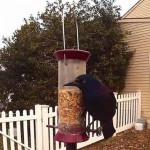
Image of a Common Grackle captured on an overcast day by the SJCAM 4000
Note: I have no commercial interest in any of these products. There are probably several other products and methods that would produce satisfactory results. I set out with certain goals in mind and looked for products that would let me accomplish them. This blog post shares my process of discovery.
The SJCAM 4000 field of view extends across 170 degrees. These images have been cropped and some photo processing may have been done to enhance the images. However, both cameras can achieve very good levels of clarity and resolution. Each has features and capabilities that the other does not. Both will continue to find a use in my photography. The SJCAM 4000 does have the edge on video given that it is capable of HD quality video.
The low resolution images required for the Internet do not properly convey the quality of images. To see better quality images and video samples for both cameras follow the link to my Flickr album of bird cam images. All images in this post and on Flickr are copyright Murdo Morrison and may not be used without permission.
January 10, 2015
A Merchant Marine Veteran of WW2 Tells His Story
In 1936, George Graydon, then a young teenager, went to sea as a deckhand. Within a few short years, through hard work and determination, he rose to the position of bridge officer. During World War 2, George served in a number of ships including the cargo ship Harpalion and the rescue ship Zamalek (learn more about the Zamalek in my blog post about the ship). His wartime service included British coastal convoys and convoys between Britain and North America and Russia.
In January of 2015 I spoke with George about his experiences. In the interview George speaks candidly about his wartime experience, the hardships of the sea and the frequent lack of appreciation of the contributions of merchant seamen during and after the war.
This file is being made available for informational purposes for your own use. Any other use, including commercial or non-commercial reuse requires permission.
March 19, 2014
The Thistle – A Meditation for Tartan Day
One of the most powerful symbols of Scotland and things Scottish, is the thistle. Every Scot has heard some variation of the story about the enemy that were creeping up on the unsuspecting Scots and stepped on this prickly plant. Anyone who has had a close encounter with a thistle might almost feel sorry for them. And I know of few Scots who would willingly pick one, as portrayed in the movie Braveheart, when Wallace is handed a thistle by his sweetheart. I can only presume that many Scots snorted in disbelief when they saw that.
So often used as a metaphor for Scotland, one might almost take the thistle for granted or consider it a cliche. As a symbol, though, it has endured and there must be a reason for that. I would like to think that Scots see it as an emblem of their own stubbornness and unwillingness to give in to circumstance. Certainly the plant has a number of characteristics that are reminiscent of the Scottish temperament. It is prickly, persistent, wanders far afield, quietly moves in and takes over, and is considered by many to be a bloody nuisance. Yet, hidden behind its gruff exterior, is a kinder heart.
The thistle is of a lineage that has long been in the human herbarium, provides food for birds and insects and some even consider it worthy to present at table. As a native-born Scot, I have seen the thistle in its many variant forms for as long as I can remember. It is prominent on the masthead of The Scotsman newspaper, other print publications and even online. One of its more abstract manifestations has been its use as a symbol of the Scottish National Party. It also persists in more conventional form in countless linen table cloths, dish towels and other souvenirs sent overseas to relatives in Canada and the United States.
But perhaps in its nomadic ways, the thistle best symbolizes that Scottish diaspora that has brought so much talent to the world and particularly to North America. Many are not aware of the extent of that contribution. The Scots are quiet about their achievements and St. Andrew’s Day (November 30th.) passes largely unnoticed by most others. But, for a small country, Scotland has made a great name for itself and people of Scottish heritage have touched every corner of the planet.
We have all heard the better known names like John Muir, Andrew Carnegie, John Paul Jones and Alexander Graham Bell. But countless unnamed individuals have made amazing contributions in their wandering, building and striving. To them I pay tribute. We owe them a great deal.
Scots have been coming to North America for a long time. I am heir to an old tradition. Born in Glasgow, doubly blessed to be Scottish and Glaswegian, I have lived in the United States for more than forty years. My paternal grandfather, also Murdo Morrison, was born in the Isle of Lewis, the Morrison heartland. Speaking Gaelic as a first language he moved to Glasgow to find work. My father, Donald, born in Glasgow, worked as an apprentice in John Brown’s yard, Clydebank, during that time when the the great ocean liners were being built. During World War II he served on the Atlantic and Russian convoys and later worked for another 30 years building ships at Yarrow’s in Scotstoun, Glasgow. I started life under the shadow of shipyard cranes within a stone’s throw of the River Clyde.
Through my mother, Ella Morrison, I am linked to the Burnetts of Fraserburgh in the northeast and to the McClartys of Campbelltown in Argyll. My maternal grandfather, Charles Burnett served on all manner of ships, including tankers on the coastal convoys. And now our offspring, all born in the USA, are the latest in the line. We Scots who have wandered from our home soil, transplanted islanders, highlanders and lowlanders, have rich stories to tell. Our collective history is woven into the fabric of Scotland and North America.
For the last few years a thistle has appeared in my garden. Whether brought by a bird or some wayward Scottish spirit, it is left unmolested. I keep its presence quiet and, if anyone asks, explain its existence as food for the birds. But it is really its symbolic power that keeps it in my garden. I doubt if it is a Scottish thistle but I feel that, having found me, it must be close kin to it. It is a quiet sentry guarding my heritage and reminding me of who I am.
Tartan Day (April 6) celebrates the contributions of Americans of Scottish heritage.
I am a writer, podcaster and staff member at Podioracket.com. My books include Roses of Winter and The Taste of Dust.
January 11, 2014
My Life in a Glasgow Housing Scheme – Drumchapel in the 1950s and ’60s
 In my previous post, My Life in a Glasgow Tenement in the 1950s, I described what it was like to be a child in a Scotstoun tenement. In 1957 we moved to a recently built part of Drumchapel, a large housing scheme on the edge of the city. It was so new that, when I first saw it, the sidewalks were not yet paved. We considered the new flat an improvement since it had an inside toilet and bath, but by modern standards it was still pretty primitive.
In my previous post, My Life in a Glasgow Tenement in the 1950s, I described what it was like to be a child in a Scotstoun tenement. In 1957 we moved to a recently built part of Drumchapel, a large housing scheme on the edge of the city. It was so new that, when I first saw it, the sidewalks were not yet paved. We considered the new flat an improvement since it had an inside toilet and bath, but by modern standards it was still pretty primitive.
For example, the only source of heat was a coal fire in the living room. In addition to providing heat for the main room this also heated water in a tank that resided in a closet in the main bedroom. The lack of central heating meant that in winter, even a few feet away from the fire, you felt cold. The bedrooms were unheated. I remember my father setting up an electric space heater several hours before we went to bed to remove the chill from the air. Hot water bottles were used to warm the beds. I remember many mornings when frost created lovely but frigid patterns on the window and frozen moisture from our breathing clung to the inside of the windows.
The bathroom contained a toilet, a sink and a bathtub. Taking a bath in winter required a certain amount of fortitude. In my teenage years I insisted on obtaining a portable shower unit. This was an unsatisfactory solution. The curtain rail was attached to the wall with hooks and a chain and the rubber hose had two ends that fitted on to the hot and cold water taps. Keeping the water adjusted to the right temperature was a challenge and the hoses had a habit of falling off the taps, causing you to be frozen or scalded.
The flat overall, was small in today’s terms. A lobby extended from the front door to the living room. The main bedroom, which my parents occupied, was to the left, and just before the living room door was a short passage that led to the bathroom and the bedroom I shared with my brother and sister. A small kitchen was accessed from the living room. Near the front door was a coal bunker. This had an outer hatch that could be locked and an inner door that provided access to the coal from inside. The coal arrived in sacks carried on the back of a man who came around the housing scheme. You called out from the window and he brought it up.
Six similar flats on three landings made up one close. The ground floor entrance that provided access to the stair case also extended to another opening on the rear that led to small plots where residents could grow vegetables. My father planted potatoes and allowed me a small space to plant flowers such as nasturtiums.
We had few of the things that people take for granted today. A radio or wireless was a common find in many tenements but television was a rarity in the 1950s. In 1957 or ’58 my father obtained a used television. The picture was black and white (color television did not appear in Britain until late in the 1960s and we would have been unable to afford it anyway). Primitive as it was, though, that old television was a marvel to us. It broke down fairly often and I remember quite a few times when my father’s pal, who was handy with such things, would stop by and help him fix it. The TV was basically a box with a back that unscrewed, allowing the chassis to slide out. Usually the problem was a failed tube (or valve as we called them then). Each one had to be removed and tested. Care had to be taken with the TV tube, which could provide a dangerous shock even when turned off.
Another form of entertainment was an old wind up gramophone that my father had brought back from America in World War 2. He had numerous 78 rpm records, including big bands and short classical pieces. In the 1960s we eventually bought a new electric record player but that old gramophone instilled a love of music from the 1940s that remains with me today. Also, people are surprised when I tell them that early records by Elvis Presley were issued in 78 rpm format.
There were many other activities that occupied our time. Books were a huge part of my life then and remain so today. Thank goodness for the public library, which I visited often. There were also games, comic books, jigsaw puzzles, paintboxes and other simple pleasures. And often, when the weather allowed, we would go outside. Our block of tenements lay on the very edge of the city. Immediately behind us was a wood that we called the bluebell wood, because in summer it was carpeted with the flowers. At least it was in the beginning. That wood received heavy use from neighborhood kids, myself included. We roamed all over it, ignoring nervous mothers’ instructions to ‘stay where they could see us.’
At other times we would play football (soccer) or cricket. My father had hoped, I believe, for a kid who shared his sports ability. He bought me a nice leather football and football boots but unfortunately my bookish nature did not extend to similar skills. He was a good sport about it, though, and would often bring me home books and comics. I also owned a cricket bat, ball and stumps. This ensured that I would be included in the neighborhood games but did not prevent me being picked last when teams were selected.
Until 1968 we had neither refrigerator or telephone. The lack of the first meant that perishable items had to be purchased on a daily basis. The lack of the second meant that, if you needed to call the doctor, or get word to family members (if they had a telephone of their own), you went to the local telephone box or made a bus trip to inform them in person. I remember my uncle coming all the way out to Drumchapel to let us know that my grandmother had died.
One of the unfortunate aspects of coal as a source of heat was that we often experienced dense smogs so thick that they could literally slow traffic to walking pace. People in Glasgow even to this day describe this as fog. But fog is a natural phenomenon that does not shorten your life. These were opaque grey-green clouds of coal smoke, mostly from domestic hearths, mixed in with industrial pollution. Images from that time show how dark the city could get during one of these events. Smoke control laws enacted in the late 1960s eventually stopped these.
Such experiences have influenced my writing, particularly in my book , which includes passages describing the life of a young boy in Glasgow during the time period I describe here.
My life now is so completely different. I could not have imagined as a young boy what it would be like to move to a different country and use the types of technology that are now commonplace. My early experiences, however, have shaped my thinking in countless ways and helped me take little for granted.
Listen to a short excerpt from The Taste of Dust. The passage describes an early winter morning in a Drumchapel tenement.
http://www.rosesofwinter.com/Blog/wp-content/uploads/2014/01/The-Taste-of-Dust-excerpt-processed.mp3
I am a writer, podcaster and staff member at Podioracket.com.
December 17, 2013
Research and the Writer
An old and perhaps worn out cliche about writing is ‘write what you know.’ In beginning any new project I generally assume that I know very little about the theme I have chosen. This is true even when I am writing about places, time periods and cultures that I am somewhat familiar with.
One of my books, Roses of Winter, is set in my home city of Glasgow, Scotland during World War II. I was born five years after the war ended so have no direct experience of it. Fortunately, the interiors and street scenes that I did experience in the city of the 1950s and early 1960s were broadly similar to those of the 1940s. However, there remained a lot of details that needed to be pinned down.
The book also included the wartime adventures of male members of the two families that are featured in the story. One served on a rescue ship in a convoy to Murmansk, another found himself stranded on the beaches during the Dunkirk evacuation. These scenarios created another set of research needs.
The types of information I needed ranged from general background to the highly specific. To find the answers required a mix of strategies. They included interviews, internet searches, seeking out books and papers on various topics, and visits to archives.
Interviews
I was fortunate to have access to a number of older relatives who had lived in various neighborhoods and experienced the war first hand. Before speaking with them I created a detailed list of questions that would meet my information needs. Many were quite basic such as ‘where did you buy bread and other groceries,’ or ‘how did you get from here to there during the war.’ This helped me develop a sense of the lifestyle as well as provide interesting details I might not otherwise have known. One interesting point is that, since I was in the US and my family were in Britain, most of these interviews were carried out over the internet using VOIP, an inexpensive method that allowed long conversations. Skype is another way to do this. Recording is an option if your subject is agreeable.
Internet searches
I used the internet in several different ways. They can be summarized as follows:
1. Searching for books and other materials
2. Finding people with direct experience of particular events
3. Looking for newspapers and radio broadcasts from the time period
4. Seeking personal accounts
5. Locating historic images
6. Establishing physical details such as sunrise and sunset, temperature ranges, geographical details.
Many of these are fairly straightforward so I will focus on my experience with finding people. An important part of this strategy was to seek out sites and message boards where people gathered to discuss a variety of topics. Some were related to life in Glasgow, others were places frequented by former merchant seamen or naval personnel. Placing queries on a number of these produced very useful and sometimes surprising results. Some had previously unpublished images. Others were willing to be interviewed. One individual who had served as an officer on board a rescue ship in the arctic agreed to read those chapters and comment on how accurate they were.
One note of caution. Memories of events recalled decades later are often imperfect. Always attempt to verify information from other sources.
Archives
Archives are increasingly being digitized and made available online. However, you may find in some cases that it is necessary to visit in person. Whenever possible it helps to visit if only for the personal connection with subject matter experts. In 2005 I visited the archive at Clydebank library looking for information about the Clydebank Blitz. The reference librarian was extremely helpful and extracted a great deal of information and images for me to examine. I ended up licensing one of the images for the cover of the book.
Another advantage of being in-situ is that it sometimes enhances the imagination. During my archive search I discovered that I was sitting in the room that had been the Civil Defense headquarters during the blitz. In fact, a portion of the library had been damaged by a German bomb. Communications lines were cut and messages were sent to various locations in Clydebank using bicycle messengers. Imagine cycling through an air raid. I doubt that I would have known that otherwise.
It is important to be efficient in gathering information and keeping it organized. This allows you to economize on time and money. Technology exists to help with this. Before visiting archives I recommend putting together a portable kit. Some items to consider include a digital camera, a portable scanner, a laptop, portable digital recorder, iPad with keyboard. Some institutions may have rules that restrict use of particular devices but many are now recognizing that times have changed.
Putting it all together
The point of research (apart from achieving accuracy) is to breathe life into the story. In the case of Roses of Winter, we all know how the war turned out but the characters do not. For the story to seem real they must experience their lives in real time. It is important to provide just enough of the history so that the reader knows what is going on. I used actual newspapers and radio broadcasts as part of this process. But it has to be done lightly. The history must emerge in ways that fit the story and through the experience of the characters.
One challenge is to keep all the various stories lines straight while making sure the history in the background is correct. This is similar to the concept of continuity in movies. I find it helpful to construct timelines. In some of the more complex chapters, I inserted notes that I later removed. This helped me find and correct some continuity issues. Now I use software such as Aeon Timeline to achieve the same purpose. This allows a visual approach that combines various layers that can easily be compared. In my current project I have the real history as one layer, major story components as a second layer, and the time range for each chapter as a third layer.
Many of my projects require a great deal of research. My current story is set in early 19th. century Baltimore. The learning curve has been steep. Much of what I discover may never make it into the final book. What does must serve the story.
I am a writer, podcaster and staff member at Podioracket.com.
December 11, 2013
Technology Changes – It’s Content That Matters
 I have seen a lot of technological change in my time. Contrary to the stereotype that people my age (I am 63) don’t get technology or know how to use it, I embrace it. At least the parts that are useful to me. I think the reason is that I remember how primitive things were when I was younger. Do you really think my generation wouldn’t have been excited about an iPod or an iPad? Think again.
I have seen a lot of technological change in my time. Contrary to the stereotype that people my age (I am 63) don’t get technology or know how to use it, I embrace it. At least the parts that are useful to me. I think the reason is that I remember how primitive things were when I was younger. Do you really think my generation wouldn’t have been excited about an iPod or an iPad? Think again.
That’s the perspective from which I observe online discussions about ‘real’ books vs ebooks or CDs and vinyl vs. various digital formats. Before we get into one of those usually heated discussions let me say up front that I don’t really care what you prefer to use. ‘Use it in good health,’ as the saying goes. Over six decades I have acquired a lot of books and music in a variety of formats. In terms of utility, however, newer technologies have certain advantages over previous ones. The less convenient the format the less likely I am to use it.
Let’s talk about books. I like old style books as well as anyone but they quickly become a liability. Not long ago I had to add one more bookcase in the last possible place where it would fit (the piles of books on the floor were a tripping hazard). I suppose I could have weeded out older volumes to make room but, like attempting to create a household inventory, the task quickly becomes a pain. Therefore, recently I have been buying a lot more books in Kindle format. But not all – it depends on what I want them for. For example, books on art work best in paper format (at least thus far). For research purposes ebooks win out over paper.
Let’s say I need to find a quote or a fact but I don’t remember where I saw it. Ebooks have search functions. Let’s also say that I want to find every instance of a particular topic throughout a book. My Kindle app will list the results. I find an unfamiliar word or phrase? Ebooks give me instant access to online dictionaries and search tools that I can use ‘on the fly.’ I want to bookmark or highlight items? No problem. Creating notes? Easy. I want to download a map? A well designed ebook will allow that. Then there is the capacity to include sound and video files. Am I willing to sacrifice this utility for the frequently asserted supposed aesthetic appeal of the ‘smell and feel’ of paper books? Not a chance. And I can store hundreds of these highly useful ebooks on my highly transportable iPad.
I am typing this on a laptop but I could just as easily be doing it on my iPad. My iPad is the single most useful tool I have owned to date. That does not mean that it is a perfect tool or that I consider myself an unthinking Apple acolyte. But, with the addition of a  few accessories, a range of uses become possible. For example, together with my Zagg combined keyboard and case, it makes a compact and portable workstation. An Apple camera connector allows me to connect a USB microphone for podcasting and spoken word recording. Or, if I want to use one of my studio quality condenser microphones, I can connect it using a handy device such as the iRig PRE.
few accessories, a range of uses become possible. For example, together with my Zagg combined keyboard and case, it makes a compact and portable workstation. An Apple camera connector allows me to connect a USB microphone for podcasting and spoken word recording. Or, if I want to use one of my studio quality condenser microphones, I can connect it using a handy device such as the iRig PRE.
If you don’t like iPads use something else. My point is that we need to stop letting our attitudes to a particular technology get in the way of finding creative ways to use it. Going back to those online discussions about the merits of older technologies, the participants often seem to be missing the point. Change is constant. While you are complaining about a particular technology it is already being replaced. I think that many people find this intimidating and, instead of trying to adapt, make a virtue out of older technologies. Or say that they do.
I am involved in a number of creative pursuits and collaborate on projects with other people. My focus is on learning the new skills I need to keep up, not looking backward to out of date methods that, frankly, are not as great as some claim them to be. Ease of use and the ability to quickly manipulate content is very important. There is, however, one aspect of technological change that I am forced to pay attention to, if only for pragmatic reasons. As a content creator I need to assess where most of the potential audience are at in the technology spectrum. It is important to make sure that my work is available in the formats that people are currently using.
I am not nostalgic about the past. I was a child in the 1950s, a teenager in the 1960s. I do not consider either decade a halcyon time (except for the soundtrack). What was available to us suffered from the limits of technology at the time. That is no less true today. I have gone from 78 rpm records to iPods. I remember once in the 1960s, probably when I was fiddling with a stylus gauge, my father telling me that I spent more time adjusting the stereo than listening to it. He was right, of course. It’s about the content.
I am a writer, podcaster and staff member at Podioracket.com.
I used my iPad rig to record the role of Dr. Andrew MacGillivray in the dramatic podcast Black Magic, written and produced by Dan Shaurette.
March 15, 2013
Recording with an IPad
 I have been recording spoken word for several years. Until recently I used a typical home studio setup with an audio interface connected to a laptop. When I first got my IPad 2 I was interested in discovering how many things I could do with it. Recording sound of any quality appeared to be a challenge.
I have been recording spoken word for several years. Until recently I used a typical home studio setup with an audio interface connected to a laptop. When I first got my IPad 2 I was interested in discovering how many things I could do with it. Recording sound of any quality appeared to be a challenge.
As new accessories for the IPad became available I revisited the issue of using it as a very portable recording device. Conducting periodic online searches I discovered that Apple’s camera connector could be used to connect a USB microphone. I purchased an Audio Technica AT2020 and tried it with very good results.
There was still no way to connect other microphones with XLR connectors. Alesis produced a dock for the IPad that acted as an interface but I waited, wondering what new products might be in the works.
Recently, a new device, the IRig PRE became available. This is a small, relatively inexpensive interface that serves one purpose, it allows you to connect an XLR cable to the headphone jack of the IPad.
The image to the right shows a recording set up  I have put together using my IPad and the IRig PRE. The mic is an AKG Perception 220, the pop filter is the Stedman ProScreen XL and the IPad holder is by K&M. All are supported by a heavy duty microphone stand, providing a complete recording set up that does not occupy a lot of space.
I have put together using my IPad and the IRig PRE. The mic is an AKG Perception 220, the pop filter is the Stedman ProScreen XL and the IPad holder is by K&M. All are supported by a heavy duty microphone stand, providing a complete recording set up that does not occupy a lot of space.
There are a number of recording applications available for the IPad including a version of Garage Band. The application that I use most often is Twisted Wave. Twisted Wave offers a number of editing features and allows you to export sound files in a variety of commonly used formats to a number of destinations.
These images illustrate some of the features of Twisted Wave including export options and file formats.
Twisted Wave works well for the type of recording I usually do. I suggest that you look at what is available and choose one that meets your recording needs.
Murdo Morrison
I am a writer, podcaster and staff member at Podioracket.com.
November 28, 2012
How novel should a novel be?
We can all think of writers whose books we are told we should like. How many times have you explored an acclaimed author’s work and found it to be a tough read? In some cases the reader is left with the impression of self-indulgence on the part of the author. In others the writer may be striving for a particular literary effect that makes the book impenetrable for all but the most admiring critic. Yet other writers have built careers writing essentially the same book multiple times. When I embark on a new writing project (as I am currently) I find it a good time to reevaluate what I have done before and think about where I want to advance to next. High on my list of priorities is the issue of proving a meaningful, challenging experience for the reader while keeping the book readable.
There are a number of reasons why readers pick up a particular book. Many say they read for entertainment. There is certainly something to be said for a story that is simply engaging and many writers are happy to supply that demand. In my own case, while I strive to make any story I write compelling, I also have in mind, consciously or otherwise, the notion that what I compose should compel the reader to look at the world in unfamiliar ways or immerse him or her in a particular time and setting.
Many of us have a tendency to want things we read to reaffirm our view of the world. This raises a number of potential issues for writers. In fictional or dramatic works growth for a character often comes as a result of being made to face a challenge or deal with conflict. Writers can use that fictional tension to engage readers in ways that cause them to reeaxmine their preconceived ideas about the world.
I am not talking about writing ‘message books’ or pushing advocacy disguised as fiction. My point is that writers should not limit the scope of their creative process by worrying too much about what is likely to please the reader or tell them what they want to hear. For example, in my latest book, The Taste of Dust, I created a character who has developed a philosophy of life that keeps him in a constant state of uncertainty. His unwillingness to fully accept anything, including religion, makes sense in view of his upbringing and life experiences. By allowing the reader access to his inner world I am able to say something interesting about the character and, by extension, life in general.
Most writers want to sell books. I am no exception. However, as a writer, I have important goals that extend well beyond adding up the sales numbers. Have I created books of lasting value? Have I challenged the reader? It is an approach that may not guarantee instant success or significant returns over the longer term. I try not to think of that when deeply involved in the writing process. What I do think of is that when my name goes on the front of the book I have to be proud to have written it.
Enter my Goodreads.com giveaway for a chance to win a copy of The Taste of Dust (ends December 20, 2012).
June 11, 2012
Reviews – Why They Require Critical Thinking
 When I visit online discussion groups for aspiring and independent writers (something I do much less often these days) I am struck by the frequency of topics that are in some way associated with reviews. An email I received recently from a potential reader of my book Roses of Winter on this topic has helped me focus my thinking a little more about what troubles me concerning much of what I read.
When I visit online discussion groups for aspiring and independent writers (something I do much less often these days) I am struck by the frequency of topics that are in some way associated with reviews. An email I received recently from a potential reader of my book Roses of Winter on this topic has helped me focus my thinking a little more about what troubles me concerning much of what I read.
The email contained the following statement:
“Please be assured that I will read it and give it the very best rating I possibly can. I will post both here and on Amazon.com with a full review. If I cannot honestly give you a 3, 4 or 5 star review with glowing praise, I will let you know via message — and will post nothing negative for public view.”
Here is my response:
“Your offer to provide advance notice of your opinion about the book is very kind and appreciated. I would just like to share with you my philosophy about reviews. Every reader is entitled to their opinion about a book. It will not speak to everyone in the same way. I encourage you to provide your own honest reaction to the story. In that regard it is better for me to be removed from the process of responding to the book. My preference is that you publish whatever you want to say about the book, positive or negative, exactly as you find it and without prior reference to me. For me this is an attempt to preserve the integrity of the review process. I hope you understand. I have every confidence that you will be fair and balanced in whatever you decide to write. Also, thank you for offering to post your review on Amazon. Many readers don’t take that extra step.”
Let me say at the outset that I love to hear from readers and I like to read thoughtful reviews of my books, particularly when the reader provides insights about what they liked and didn’t like. This is important information to have. A writer should be willing to listen to the negative along with the positive. However, a pattern of negative comments may well indicate problems that should have been resolved earlier in the writing process. This is particularly true when comments focus on the technical aspects of writing and structure. It is much better to receive this type of critique from test readers before publication than after.
A bad rating or review, even if received after publication, does not necessarily reflect negatively on your book. It depends on the nature of the review. I quite often have the experience of liking or disliking a book and finding comments and rating completely at odds with my perception. The reasons for this are varied. There are a number of factors that come into play in the review process. Here are some of the major ones that come to mind:
Writing quality,
Technical quality and production values,
Story
Genre
Reader preferences,
Reader expectations,
Reading background of the reviewer.
When I published Roses of Winter I made every effort possible to issue a quality product. The book went through extensive editing and proofreading. A lot of time also went into choosing fonts, formatting the structure of the book and making it as appealing as possible from a physical standpoint. These were all matters that were within my control. Months of work went into the process. I was also reasonably confident that I had produced a compelling story based on the comments of test readers.
Following publication of Roses of Winter I promoted it as vigorously as possible. However, I had certain ground rules regarding reviews. One important rule was not to attempt to influence others to inflate ratings or provide favorable reviews. Nor did I rate my own book, something that I have seen some authors do but I believe to be problematic and of little value. The majority of reviews for the book have been received from people I do not know personally and were unsolicited.
In addition to being a writer I am a voracious reader, an obsession that has persisted from early childhood. I will often look at reviews before I purchase a book. Invariably there is a wide range of opinions and I will typically read a number of reviews associated with ratings that range from high low. While reviews can influence my decision to purchase they are not always that helpful. The reason relates to the last three items on my list above – reader preferences, reader expectations, and reader background and experience.
There are certain genres that do not work for me. It would be unfair for me to presume to write a review of a book that belongs in those categories. That doesn’t necessarily mean that I never read books in genres that are not particular favorites of mine. I am well aware that perceptions about genre can work against a book by creating a particular expectation. For example, Roses of Winter is set in World War 2 Glasgow, Scotland. For that reason the book typically is categorized as historical fiction. A number of readers have commented that they enjoyed reading about a setting and time that they knew little about. However, I am sure that there are also readers who have passed the book by for that reason. A five or four star review is less likely to sway a reader than their reading preferences.
A rating by itself, without the addition of a thoughtful review, is of little value. There is no way to derive much significance from a standalone rating. Also, there is no objective way to compare one individual’s five star rating with that from a different individual. A review will provide a sense of what the reader thought of the book and why. It also allows you to assess the background of the reviewer. Personal perception and even bias can certainly be found in text reviews. Written opinions provide more information for the reader to analyze and make their own judgement. When it comes to my books, reviews from other writers, particularly those with a successful track record, are ones to which I pay special attention.
Many poorly written books receive good reviews while better books are ignored. A visit to any website frequented by aspiring writers will reveal that many are expending a great deal of time and energy discussing how to achieve numerous good reviews. Reviews can provide important feedback and the more thoughtful ones add value to the reading and writing community. However, it is important to recognize their limitations, particularly in a publishing environment where so many are chasing five star reviews. For many aspiring writers they may supply the illusion of success and consume time better spent in producing good writing.
Subscribe to receive updates when new posts appear.
Reviews for Roses of Winter
Other Blog Posts About Writing:
Self-publishing – What I Have Learned
March 20, 2012
Self-publishing – What I Have Learned
 Within the last decade writers and performers have gained many new tools to make it possible to present their work to a potentially world-wide audience. Some are using these tools more effectively than others. I would like to share with you some of the things I have learned in trying to become a better writer and to make the most effective use of technology in my writing.
Within the last decade writers and performers have gained many new tools to make it possible to present their work to a potentially world-wide audience. Some are using these tools more effectively than others. I would like to share with you some of the things I have learned in trying to become a better writer and to make the most effective use of technology in my writing.
The ability to disseminate content more easily does not relieve the writer of the need to make that content as compelling and well crafted as possible. The ability to self-publish means writers must be willing to take on those tasks that would otherwise be managed by a conventional publishing outlet. Two of the most important are editing and proof-reading.
I occasionally get asked to look at another writer’s work. I am very reluctant to do this. The main reason is that I find few writers, particularly those starting out, who are open to constructive suggestions or critique regarding their work. Developing a willingness to accept substantive critique was a painful and hard lesson that I had to learn in the early stages of my own writing.
If you are relatively new to writing it is important to realize that your final product will little resemble your first or even fourth drafts. If you are by nature sensitive and easily bruised emotionally you have two choices – leave writing and take up something else or learn to develop a thick skin.
In writing, as in other areas of life, you need to develop relationships with people whose judgement you trust. Friends and family members, unless they have particular expertise in writing, editing or proof-reading, are unlikely to be good choices. You need to seek out people who will provide the objective commentary that you need to improve your work.
In my writing life there are two people I turn to, one a lifelong reader, the other a meticulous editor and proof-reader. The first tells me what works and doesn’t work with the story, the second takes my prose and tells me what is technically wrong with it.
A safe assumption is that none of us possess all the tools we need to be great writers when we start out. Turning to others to provide a critique of your work does not remove the need to gain personal expertise. There are several ways to achieve this. First, do not overlook the advantage brought by being an omnivorous reader. Recognizing good prose helps us to write better prose. Classes may or may not work for you depending on the level of expertise that particular teacher and group provides. I have a similar observation to make about writing groups. The expertise (and personalities) of the members will determine how much you gain from the experience. Do not overlook the technical aspects of writing. There are countless style manuals – I have a stack of them – that you can refer to. Mine see quite frequent use. And do I need to tell you not to rely on computer spell or grammar checkers?
Attention to detail should extend to everything an aspiring writer posts online. Poor spelling, clumsy sentence structure, grammatical errors convey the wrong impression to a potential reader. We all trip up on occasion. However, persistent misuse of language signals a problem. Protect your online reputation as jealously as a company preserves its brand name.
A software tool that I find particularly useful is a product called Scrivener from Literature and Latte. I am using it to work on my current project, a sequel to Roses of Winter. Scrivener allows the writer to structure his or her project. I find it useful in keeping track of characters, plot lines and in gathering research in one place. There are probably as many ways to use Scrivener as there are writers. I use the Mac version but it is now also available for Windows.
As you gain experience you work will undoubtedly improve. A good way to look at your early work is that you are serving an apprenticeship, learning your craft. However, no matter how skilled you ultimately become, there will never be a time when you should ignore the input of others.
When I completed my first book, Roses of Winter, my first impulse was to put it out only as an ebook. It didn’t tale long to start getting questions about how to obtain the print version. I learned a lesson from that – give the reader your work in a number of common formats. Online discussion about the imminent demise of ‘dead tree’ books should be taken with a sack of salt.
As a complete novice I looked at many options to create ebook and print versions of my books, including services that do the work for you. I ended up doing the work myself. If you decide to use a service I recommend that you look carefully at the terms of the agreement for that service. I don’t have enough space here to go into all the pros and cons – you can find out what to be wary of in a careful Internet search.The important point to take away is that there is no one way to achieve your goals. If you are willing to put in some effort there are low cost solutions out there. I was able to publish my ebook in Kindle, Sony and Nook versions without using any service as an intermediary. If you are outside the US this may not apply for some sites.
There are many sites on the Internet including group forums that discuss writing and publishing. I do go to a few of these but some cautionary advice is in order. One potential problem, particularly in group discussions or forums, is that you will find many opinionated individuals who favor one particular approach. ‘Group think’ can also be a problem. It is also easy to get drawn into spending too much time discussing writing rather than doing it. You can find good advice but you need to maintain your critical faculties.

Cover of my novel Roses of Winter
Following my review of methods for creating ebooks I selected a software option. I felt that this would give me more control over formatting and the final product. Before committing to one particular product (Legend Maker for Mac) I downloaded a number of trial versions of software that looked promising and/or received good reviews. If you decide to go this route I suggest you look for tools that suit your particular preferences and situation. Try before you buy.
I created a rich text format (rtf) file that became the input to the software. This was easy to create and update. With a little trial and error I was able to produce various formats that matched the more popular ereaders such as Kindle, Nook and Sony Reader. Testing was accomplished using readers I downloaded from their respective sites and also by sending copies to people I knew who owned readers and were willing to test my version.
For the print version I decided to use CreateSpace’s print-on-demand service. Some of the factors in my decision were low set up cost, distribution across the Amazon sites and other online sellers as well as CreateSpaces’s own online store, and no need to maintain inventory. CreateSpace also provides economical proof and author copies. CreateSpace will provide an ISBN number as part of their package, you do not need to purchase one on your own. The requirement to buy an ISBN number and their much smaller market share is why I have not yet placed my ebooks on the IBooks site.
Again, I wanted to do most of the work myself. Using templates provided by CreateSpace I was able to create the body of the book. For the cover I forwarded the template and the cover image to a graphics professional. For my book Roses of Winter, the cover image was licensed at a reasonable cost from a library archive. Notice that I used the word licensed. It is important to respect copyright. If you use the work of others make sure that you have the appropriate permissions in writing. If there is a fee pay it.

Cover of my book A Hole Without Sides
One possibility is to tap your own social networks for talent. In my case I know several very skilled photographers and musicians (for the audio versions of my books) whose work fits my needs. If you know such people (which is likely) they might well be quite happy to work with you to showcase their work.
An example is the cover of my book A Hole Without Sides, which uses an image by the photographer Jean Morrison Phillips who also designed the cover.
Writing the book and getting it ready for publication are tasks that require a lot of work and focus. Perhaps harder still is the struggle to market the book and gain attention for it.
The most basic thing is to write a press release. I use a free press release service called PRLog. Here is an example of a press release I prepared for the ebook version of Roses of Winter. Since Roses of Winter is set in World War 2 Glasgow I sent press releases to media in Scotland as well as in my local area.
Another feature that I consider essential is to have a personal website and a website for your book (or books). It is possible to register distinctive web addresess for little cost at sites such as GoDaddy. This is so inexpensive that I even register sites that reflect working titles for new books. I may not ultimately use them but it is a good idea to think ahead. You may have noticed throughout this blog that, whenever I mention one of my books, I include an active link to the website for that work. Similarly, when I use my name (as at the bottom of this blog post) it is an active link to my personal website.
There are a number of websites that cater to authors and readers. One of the better known is Goodreads but there are a number of others. I will let you search those out for yourself. Here is my page on Goodreads. Goodreads, like many other sites, has discussion groups. Whatever site you frequent I recommend that you take time to acquaint yourself with the local rules of the road and customs. It is common for such groups to have one place where authors can talk about their work but they often frown on attempts to do so elsewhere.
Some of the things I have done to promote my work on Goodreads is to have a Question and Answer session about Roses of Winter. Currently I am running giveaways on Goodreads for the paperback version of Roses of Winter and A Hole Without Sides to draw attention to both books. Clicking on each book title above will take you to the giveaway for that book. Who knows, you may be one of the lucky ones to win a free copy of the paperback versions.
There may be sites that are a good fit for your material. Here is one example. Since Roses of Winter is historical fiction it is also featured on Past Times Books, a site that specializes in this genre and caters to its devotees.
In addition to sites that are specifically for writers and readers I use social media such as Facebook, LinkedIn, Google Plus and Twitter. Yet another method to reach potential readers is the blog you are currently reading.
I am always thinking about how to promote my books. However, it is necessary to strike some kind of balance. Overnight success is rare as is success of any kind. You need to take a long term view. Promotion, while important, should not distract us from writing. Structuring our time to do both can be a challenge. Writing books of lasting value should be our main goal. Let’s face it, for many writers, perhaps most, it also has to be the reward.
Author of Roses of Winter and A Hole Without Sides

